Teaching Portfolio 1: ABC Teacher's Philosophy and Standards
VerifiedAdded on 2023/06/10
|20
|5813
|202
Portfolio
AI Summary
This teaching portfolio, created by ABC Teacher, provides a comprehensive overview of their teaching philosophy, professional knowledge, and classroom practice. It begins with a cover letter and resume, followed by a detailed personal teaching philosophy influenced by Johann Pestoalozzi and Maria Montessori, emphasizing a homelike, engaging, and sensory-rich learning environment. The portfolio then outlines the Australian Professional Standards for Teachers, covering professional knowledge (understanding students and content), professional practice (planning, teaching strategies, classroom communication), and professional engagement. The portfolio demonstrates the teacher's commitment to understanding students' diverse learning styles, adapting teaching strategies, and creating a supportive and inclusive classroom environment. The document includes examples of lesson plans and teaching strategies, showcasing the teacher's ability to foster literacy and numeracy skills, and engage with students in a meaningful way. The portfolio highlights the teacher's experiences and skills, including their ability to develop positive relationships with students and parents, plan effective lessons, and assess student progress. The portfolio also reflects on the impacts of the COVID-19 pandemic on education and the teacher's adaptation to virtual learning environments, emphasizing the transition back to traditional classroom settings and the need to cater to students' diverse learning needs. The portfolio concludes with references and demonstrates a commitment to lifelong learning and professional development.
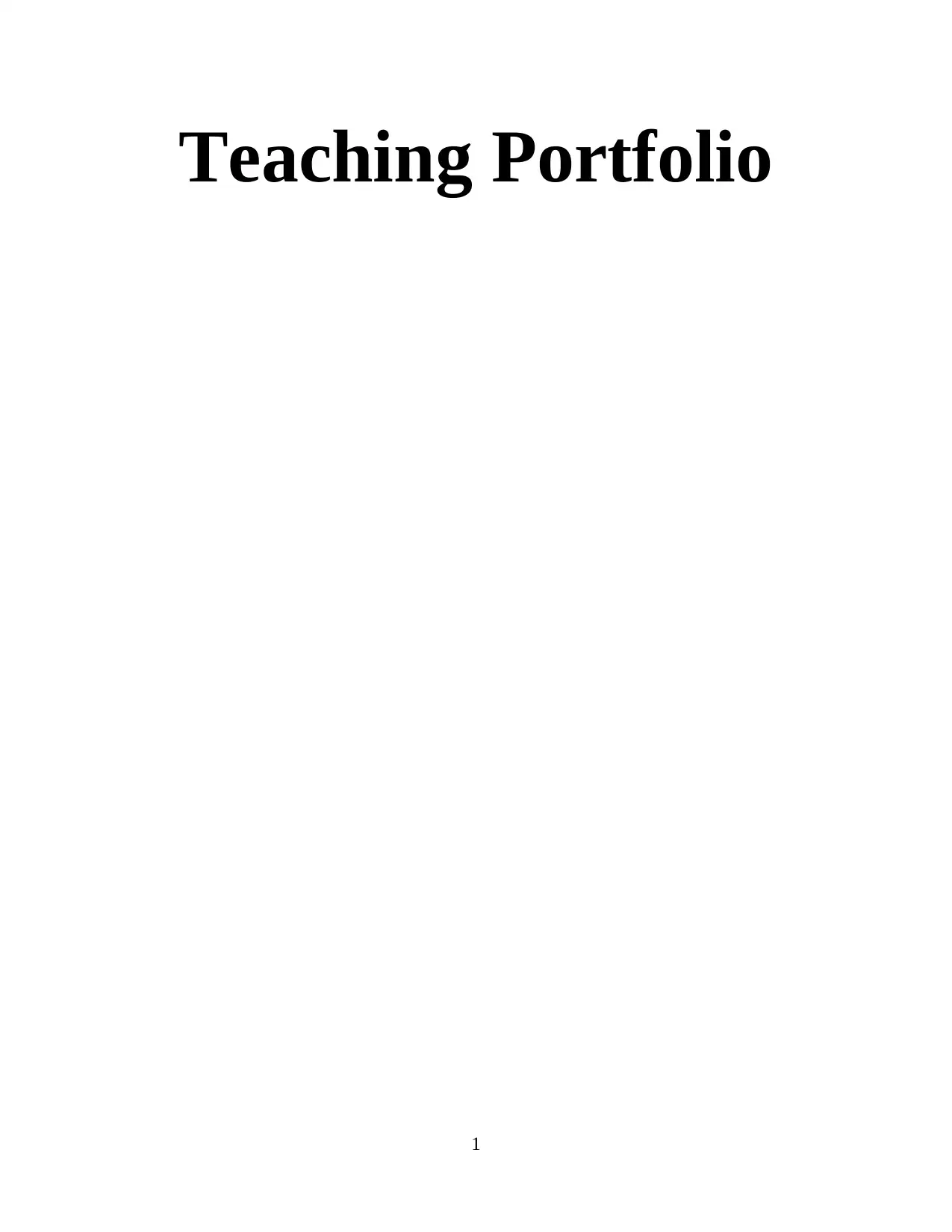
Teaching Portfolio
1
1
Paraphrase This Document
Need a fresh take? Get an instant paraphrase of this document with our AI Paraphraser
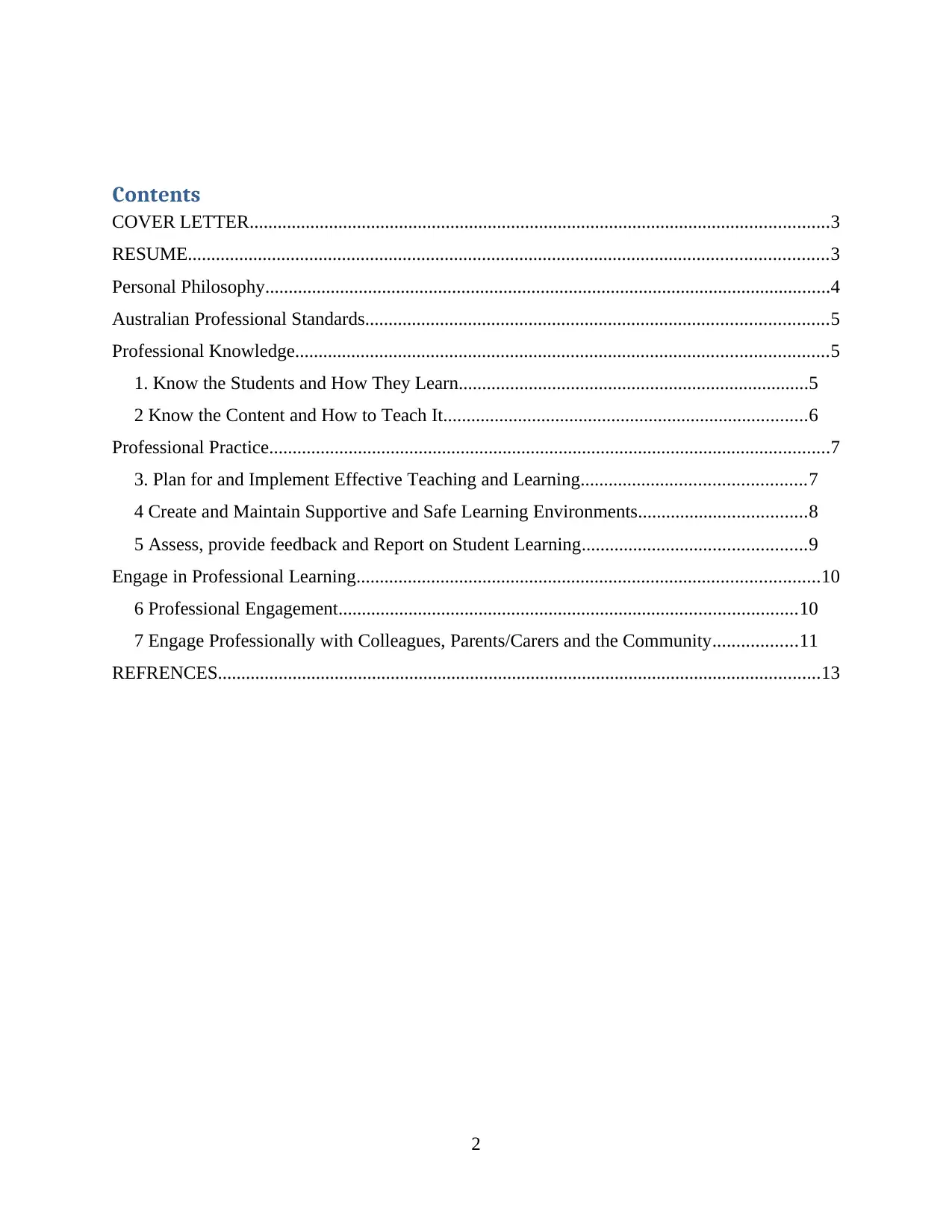
Contents
COVER LETTER............................................................................................................................3
RESUME.........................................................................................................................................3
Personal Philosophy.........................................................................................................................4
Australian Professional Standards...................................................................................................5
Professional Knowledge..................................................................................................................5
1. Know the Students and How They Learn...........................................................................5
2 Know the Content and How to Teach It..............................................................................6
Professional Practice........................................................................................................................7
3. Plan for and Implement Effective Teaching and Learning................................................7
4 Create and Maintain Supportive and Safe Learning Environments....................................8
5 Assess, provide feedback and Report on Student Learning................................................9
Engage in Professional Learning...................................................................................................10
6 Professional Engagement..................................................................................................10
7 Engage Professionally with Colleagues, Parents/Carers and the Community..................11
REFRENCES.................................................................................................................................13
2
COVER LETTER............................................................................................................................3
RESUME.........................................................................................................................................3
Personal Philosophy.........................................................................................................................4
Australian Professional Standards...................................................................................................5
Professional Knowledge..................................................................................................................5
1. Know the Students and How They Learn...........................................................................5
2 Know the Content and How to Teach It..............................................................................6
Professional Practice........................................................................................................................7
3. Plan for and Implement Effective Teaching and Learning................................................7
4 Create and Maintain Supportive and Safe Learning Environments....................................8
5 Assess, provide feedback and Report on Student Learning................................................9
Engage in Professional Learning...................................................................................................10
6 Professional Engagement..................................................................................................10
7 Engage Professionally with Colleagues, Parents/Carers and the Community..................11
REFRENCES.................................................................................................................................13
2
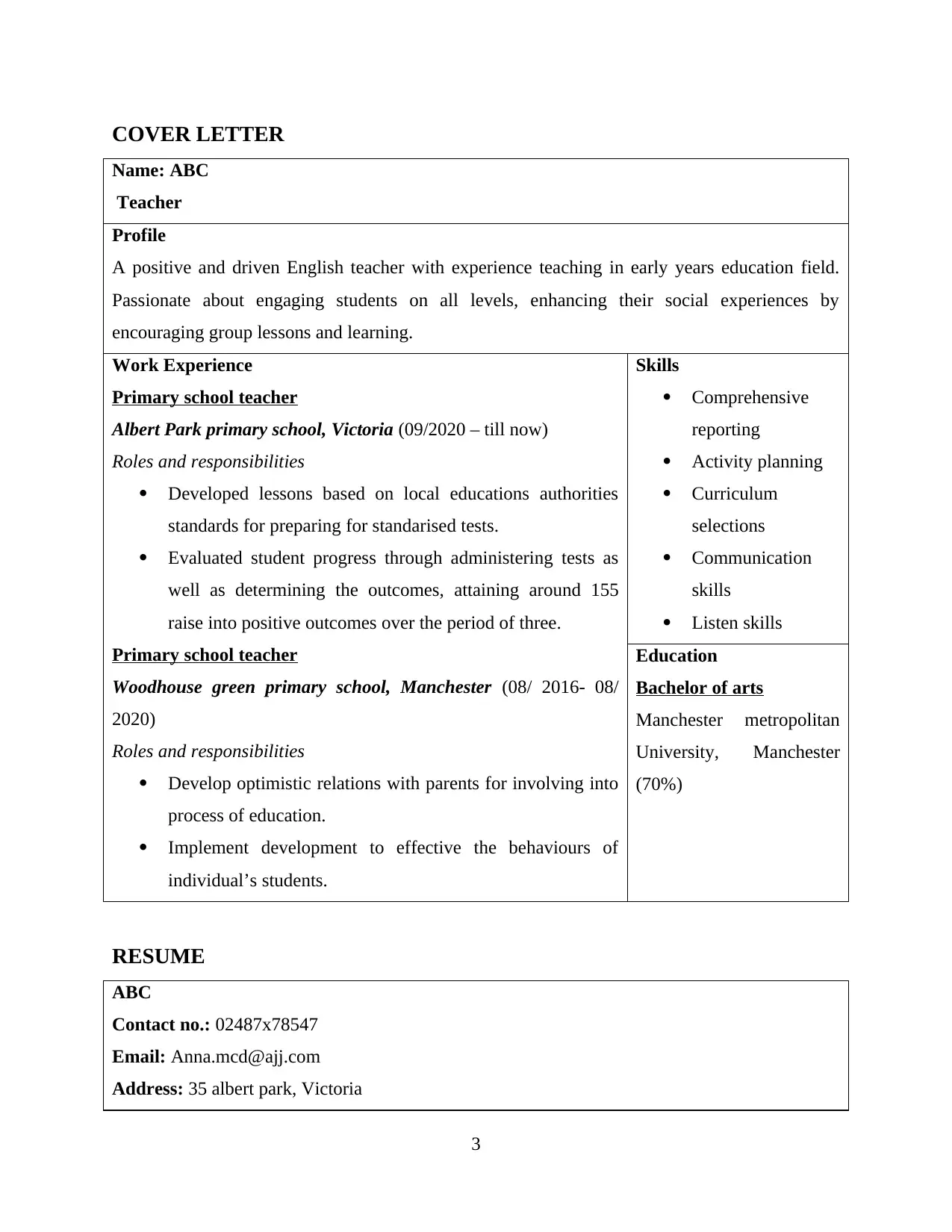
COVER LETTER
Name: ABC
Teacher
Profile
A positive and driven English teacher with experience teaching in early years education field.
Passionate about engaging students on all levels, enhancing their social experiences by
encouraging group lessons and learning.
Work Experience
Primary school teacher
Albert Park primary school, Victoria (09/2020 – till now)
Roles and responsibilities
Developed lessons based on local educations authorities
standards for preparing for standarised tests.
Evaluated student progress through administering tests as
well as determining the outcomes, attaining around 155
raise into positive outcomes over the period of three.
Primary school teacher
Woodhouse green primary school, Manchester (08/ 2016- 08/
2020)
Roles and responsibilities
Develop optimistic relations with parents for involving into
process of education.
Implement development to effective the behaviours of
individual’s students.
Skills
Comprehensive
reporting
Activity planning
Curriculum
selections
Communication
skills
Listen skills
Education
Bachelor of arts
Manchester metropolitan
University, Manchester
(70%)
RESUME
ABC
Contact no.: 02487x78547
Email: Anna.mcd@ajj.com
Address: 35 albert park, Victoria
3
Name: ABC
Teacher
Profile
A positive and driven English teacher with experience teaching in early years education field.
Passionate about engaging students on all levels, enhancing their social experiences by
encouraging group lessons and learning.
Work Experience
Primary school teacher
Albert Park primary school, Victoria (09/2020 – till now)
Roles and responsibilities
Developed lessons based on local educations authorities
standards for preparing for standarised tests.
Evaluated student progress through administering tests as
well as determining the outcomes, attaining around 155
raise into positive outcomes over the period of three.
Primary school teacher
Woodhouse green primary school, Manchester (08/ 2016- 08/
2020)
Roles and responsibilities
Develop optimistic relations with parents for involving into
process of education.
Implement development to effective the behaviours of
individual’s students.
Skills
Comprehensive
reporting
Activity planning
Curriculum
selections
Communication
skills
Listen skills
Education
Bachelor of arts
Manchester metropolitan
University, Manchester
(70%)
RESUME
ABC
Contact no.: 02487x78547
Email: Anna.mcd@ajj.com
Address: 35 albert park, Victoria
3
⊘ This is a preview!⊘
Do you want full access?
Subscribe today to unlock all pages.

Trusted by 1+ million students worldwide
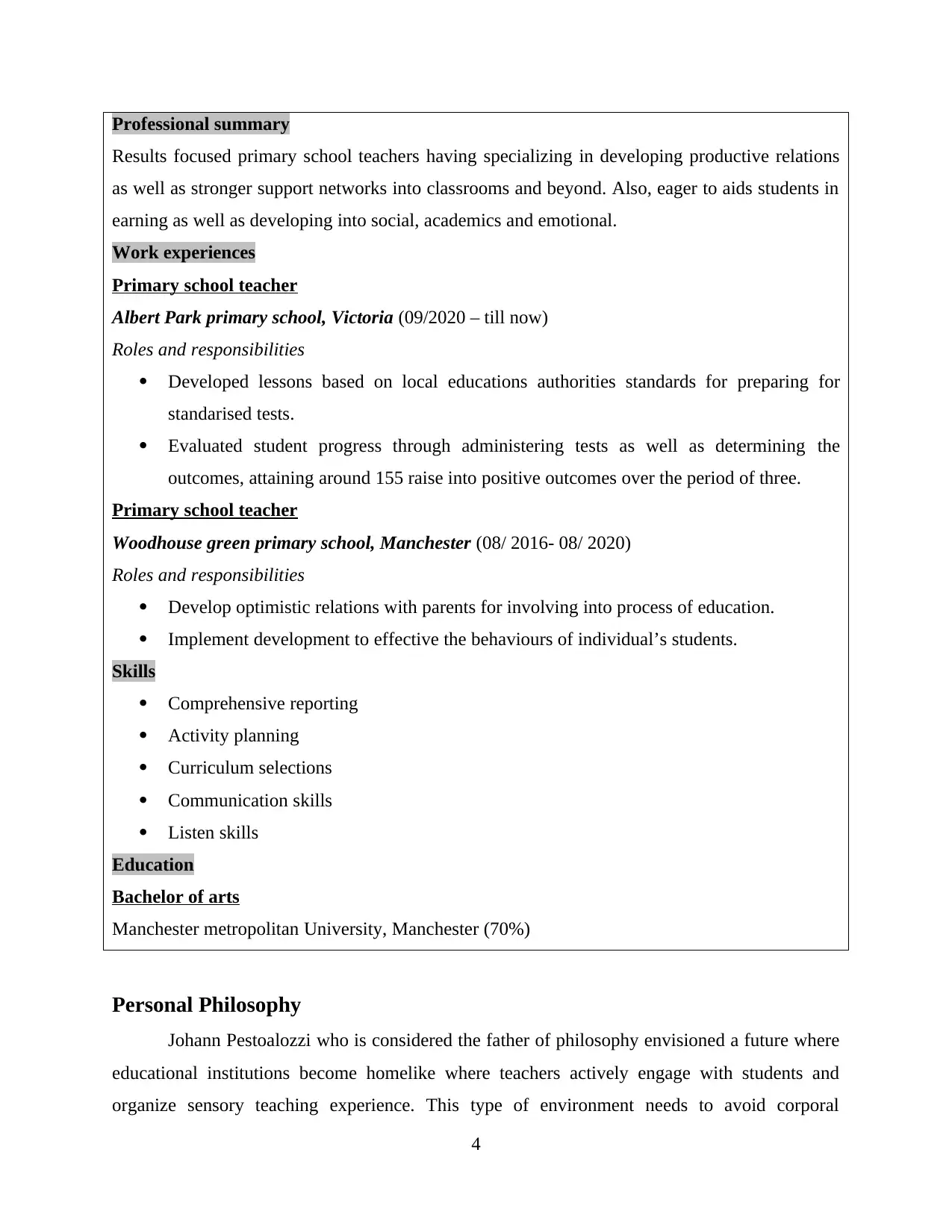
Professional summary
Results focused primary school teachers having specializing in developing productive relations
as well as stronger support networks into classrooms and beyond. Also, eager to aids students in
earning as well as developing into social, academics and emotional.
Work experiences
Primary school teacher
Albert Park primary school, Victoria (09/2020 – till now)
Roles and responsibilities
Developed lessons based on local educations authorities standards for preparing for
standarised tests.
Evaluated student progress through administering tests as well as determining the
outcomes, attaining around 155 raise into positive outcomes over the period of three.
Primary school teacher
Woodhouse green primary school, Manchester (08/ 2016- 08/ 2020)
Roles and responsibilities
Develop optimistic relations with parents for involving into process of education.
Implement development to effective the behaviours of individual’s students.
Skills
Comprehensive reporting
Activity planning
Curriculum selections
Communication skills
Listen skills
Education
Bachelor of arts
Manchester metropolitan University, Manchester (70%)
Personal Philosophy
Johann Pestoalozzi who is considered the father of philosophy envisioned a future where
educational institutions become homelike where teachers actively engage with students and
organize sensory teaching experience. This type of environment needs to avoid corporal
4
Results focused primary school teachers having specializing in developing productive relations
as well as stronger support networks into classrooms and beyond. Also, eager to aids students in
earning as well as developing into social, academics and emotional.
Work experiences
Primary school teacher
Albert Park primary school, Victoria (09/2020 – till now)
Roles and responsibilities
Developed lessons based on local educations authorities standards for preparing for
standarised tests.
Evaluated student progress through administering tests as well as determining the
outcomes, attaining around 155 raise into positive outcomes over the period of three.
Primary school teacher
Woodhouse green primary school, Manchester (08/ 2016- 08/ 2020)
Roles and responsibilities
Develop optimistic relations with parents for involving into process of education.
Implement development to effective the behaviours of individual’s students.
Skills
Comprehensive reporting
Activity planning
Curriculum selections
Communication skills
Listen skills
Education
Bachelor of arts
Manchester metropolitan University, Manchester (70%)
Personal Philosophy
Johann Pestoalozzi who is considered the father of philosophy envisioned a future where
educational institutions become homelike where teachers actively engage with students and
organize sensory teaching experience. This type of environment needs to avoid corporal
4
Paraphrase This Document
Need a fresh take? Get an instant paraphrase of this document with our AI Paraphraser
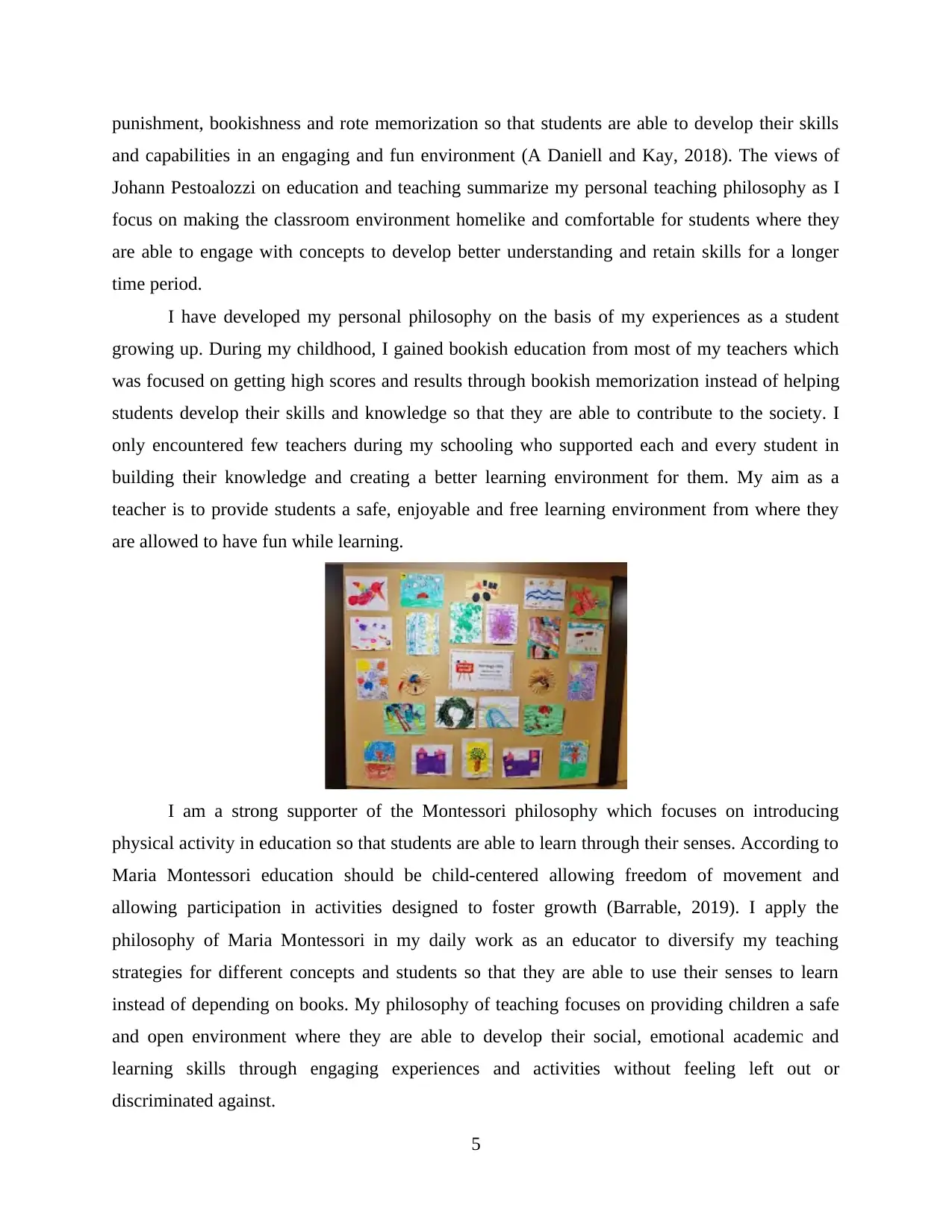
punishment, bookishness and rote memorization so that students are able to develop their skills
and capabilities in an engaging and fun environment (A Daniell and Kay, 2018). The views of
Johann Pestoalozzi on education and teaching summarize my personal teaching philosophy as I
focus on making the classroom environment homelike and comfortable for students where they
are able to engage with concepts to develop better understanding and retain skills for a longer
time period.
I have developed my personal philosophy on the basis of my experiences as a student
growing up. During my childhood, I gained bookish education from most of my teachers which
was focused on getting high scores and results through bookish memorization instead of helping
students develop their skills and knowledge so that they are able to contribute to the society. I
only encountered few teachers during my schooling who supported each and every student in
building their knowledge and creating a better learning environment for them. My aim as a
teacher is to provide students a safe, enjoyable and free learning environment from where they
are allowed to have fun while learning.
I am a strong supporter of the Montessori philosophy which focuses on introducing
physical activity in education so that students are able to learn through their senses. According to
Maria Montessori education should be child-centered allowing freedom of movement and
allowing participation in activities designed to foster growth (Barrable, 2019). I apply the
philosophy of Maria Montessori in my daily work as an educator to diversify my teaching
strategies for different concepts and students so that they are able to use their senses to learn
instead of depending on books. My philosophy of teaching focuses on providing children a safe
and open environment where they are able to develop their social, emotional academic and
learning skills through engaging experiences and activities without feeling left out or
discriminated against.
5
and capabilities in an engaging and fun environment (A Daniell and Kay, 2018). The views of
Johann Pestoalozzi on education and teaching summarize my personal teaching philosophy as I
focus on making the classroom environment homelike and comfortable for students where they
are able to engage with concepts to develop better understanding and retain skills for a longer
time period.
I have developed my personal philosophy on the basis of my experiences as a student
growing up. During my childhood, I gained bookish education from most of my teachers which
was focused on getting high scores and results through bookish memorization instead of helping
students develop their skills and knowledge so that they are able to contribute to the society. I
only encountered few teachers during my schooling who supported each and every student in
building their knowledge and creating a better learning environment for them. My aim as a
teacher is to provide students a safe, enjoyable and free learning environment from where they
are allowed to have fun while learning.
I am a strong supporter of the Montessori philosophy which focuses on introducing
physical activity in education so that students are able to learn through their senses. According to
Maria Montessori education should be child-centered allowing freedom of movement and
allowing participation in activities designed to foster growth (Barrable, 2019). I apply the
philosophy of Maria Montessori in my daily work as an educator to diversify my teaching
strategies for different concepts and students so that they are able to use their senses to learn
instead of depending on books. My philosophy of teaching focuses on providing children a safe
and open environment where they are able to develop their social, emotional academic and
learning skills through engaging experiences and activities without feeling left out or
discriminated against.
5
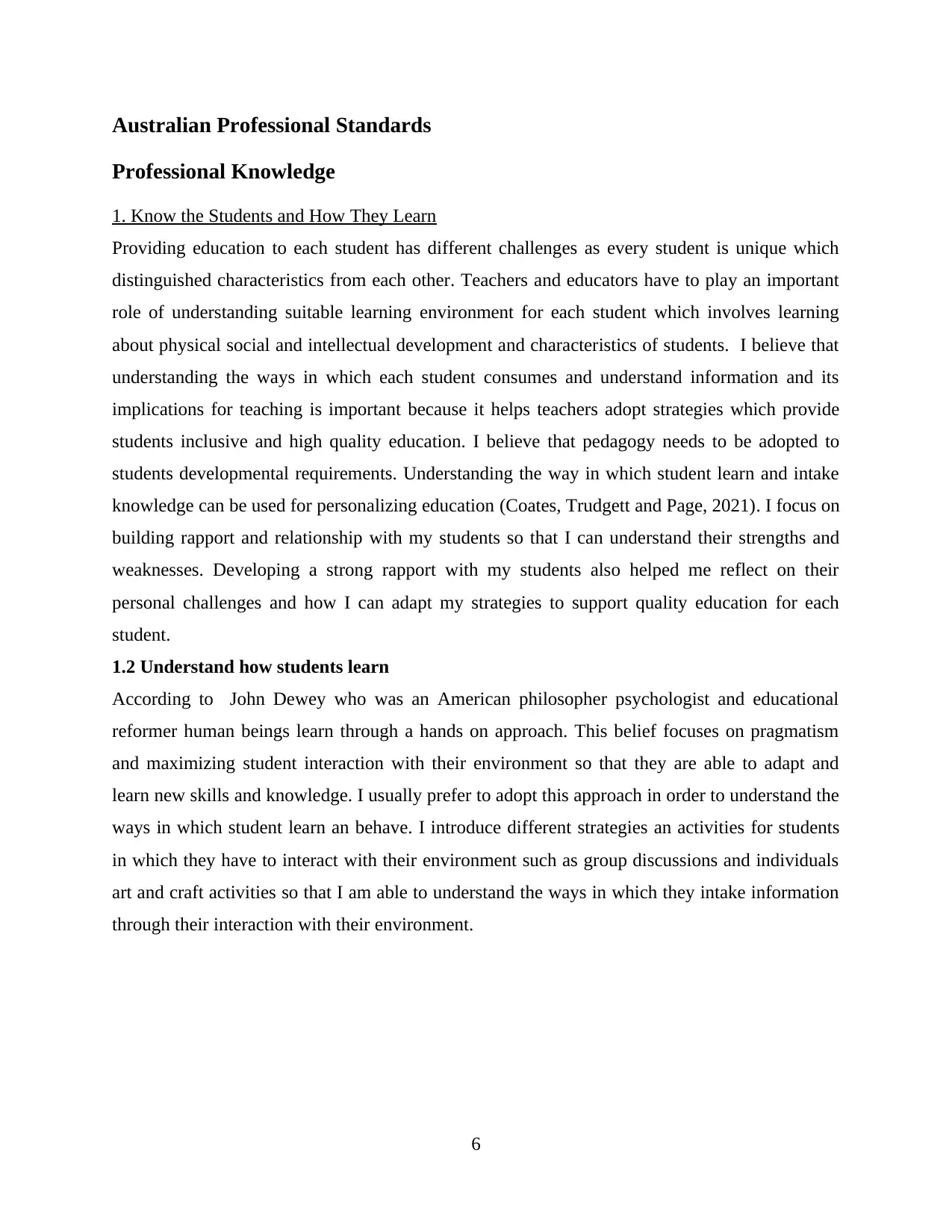
Australian Professional Standards
Professional Knowledge
1. Know the Students and How They Learn
Providing education to each student has different challenges as every student is unique which
distinguished characteristics from each other. Teachers and educators have to play an important
role of understanding suitable learning environment for each student which involves learning
about physical social and intellectual development and characteristics of students. I believe that
understanding the ways in which each student consumes and understand information and its
implications for teaching is important because it helps teachers adopt strategies which provide
students inclusive and high quality education. I believe that pedagogy needs to be adopted to
students developmental requirements. Understanding the way in which student learn and intake
knowledge can be used for personalizing education (Coates, Trudgett and Page, 2021). I focus on
building rapport and relationship with my students so that I can understand their strengths and
weaknesses. Developing a strong rapport with my students also helped me reflect on their
personal challenges and how I can adapt my strategies to support quality education for each
student.
1.2 Understand how students learn
According to John Dewey who was an American philosopher psychologist and educational
reformer human beings learn through a hands on approach. This belief focuses on pragmatism
and maximizing student interaction with their environment so that they are able to adapt and
learn new skills and knowledge. I usually prefer to adopt this approach in order to understand the
ways in which student learn an behave. I introduce different strategies an activities for students
in which they have to interact with their environment such as group discussions and individuals
art and craft activities so that I am able to understand the ways in which they intake information
through their interaction with their environment.
6
Professional Knowledge
1. Know the Students and How They Learn
Providing education to each student has different challenges as every student is unique which
distinguished characteristics from each other. Teachers and educators have to play an important
role of understanding suitable learning environment for each student which involves learning
about physical social and intellectual development and characteristics of students. I believe that
understanding the ways in which each student consumes and understand information and its
implications for teaching is important because it helps teachers adopt strategies which provide
students inclusive and high quality education. I believe that pedagogy needs to be adopted to
students developmental requirements. Understanding the way in which student learn and intake
knowledge can be used for personalizing education (Coates, Trudgett and Page, 2021). I focus on
building rapport and relationship with my students so that I can understand their strengths and
weaknesses. Developing a strong rapport with my students also helped me reflect on their
personal challenges and how I can adapt my strategies to support quality education for each
student.
1.2 Understand how students learn
According to John Dewey who was an American philosopher psychologist and educational
reformer human beings learn through a hands on approach. This belief focuses on pragmatism
and maximizing student interaction with their environment so that they are able to adapt and
learn new skills and knowledge. I usually prefer to adopt this approach in order to understand the
ways in which student learn an behave. I introduce different strategies an activities for students
in which they have to interact with their environment such as group discussions and individuals
art and craft activities so that I am able to understand the ways in which they intake information
through their interaction with their environment.
6
⊘ This is a preview!⊘
Do you want full access?
Subscribe today to unlock all pages.

Trusted by 1+ million students worldwide
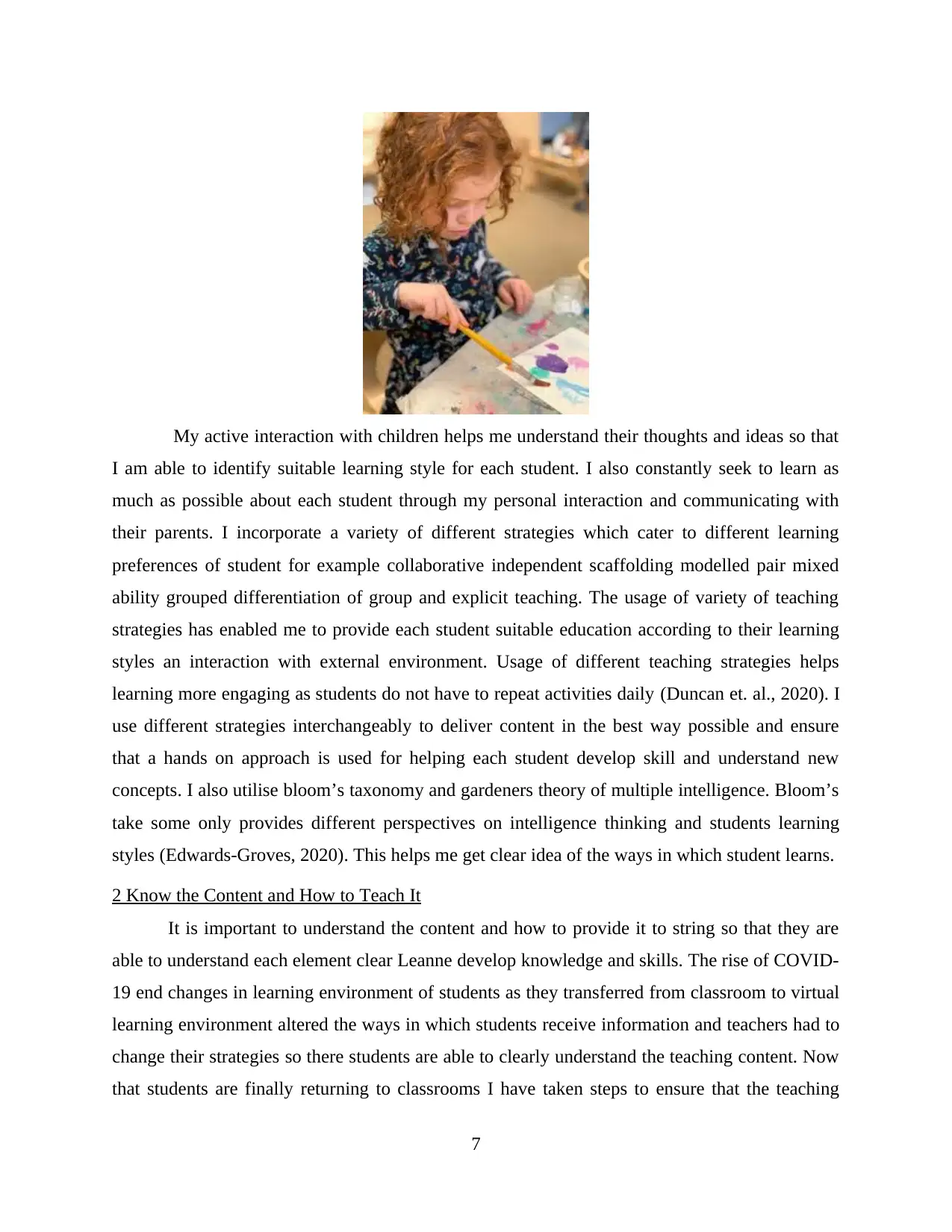
My active interaction with children helps me understand their thoughts and ideas so that
I am able to identify suitable learning style for each student. I also constantly seek to learn as
much as possible about each student through my personal interaction and communicating with
their parents. I incorporate a variety of different strategies which cater to different learning
preferences of student for example collaborative independent scaffolding modelled pair mixed
ability grouped differentiation of group and explicit teaching. The usage of variety of teaching
strategies has enabled me to provide each student suitable education according to their learning
styles an interaction with external environment. Usage of different teaching strategies helps
learning more engaging as students do not have to repeat activities daily (Duncan et. al., 2020). I
use different strategies interchangeably to deliver content in the best way possible and ensure
that a hands on approach is used for helping each student develop skill and understand new
concepts. I also utilise bloom’s taxonomy and gardeners theory of multiple intelligence. Bloom’s
take some only provides different perspectives on intelligence thinking and students learning
styles (Edwards-Groves, 2020). This helps me get clear idea of the ways in which student learns.
2 Know the Content and How to Teach It
It is important to understand the content and how to provide it to string so that they are
able to understand each element clear Leanne develop knowledge and skills. The rise of COVID-
19 end changes in learning environment of students as they transferred from classroom to virtual
learning environment altered the ways in which students receive information and teachers had to
change their strategies so there students are able to clearly understand the teaching content. Now
that students are finally returning to classrooms I have taken steps to ensure that the teaching
7
I am able to identify suitable learning style for each student. I also constantly seek to learn as
much as possible about each student through my personal interaction and communicating with
their parents. I incorporate a variety of different strategies which cater to different learning
preferences of student for example collaborative independent scaffolding modelled pair mixed
ability grouped differentiation of group and explicit teaching. The usage of variety of teaching
strategies has enabled me to provide each student suitable education according to their learning
styles an interaction with external environment. Usage of different teaching strategies helps
learning more engaging as students do not have to repeat activities daily (Duncan et. al., 2020). I
use different strategies interchangeably to deliver content in the best way possible and ensure
that a hands on approach is used for helping each student develop skill and understand new
concepts. I also utilise bloom’s taxonomy and gardeners theory of multiple intelligence. Bloom’s
take some only provides different perspectives on intelligence thinking and students learning
styles (Edwards-Groves, 2020). This helps me get clear idea of the ways in which student learns.
2 Know the Content and How to Teach It
It is important to understand the content and how to provide it to string so that they are
able to understand each element clear Leanne develop knowledge and skills. The rise of COVID-
19 end changes in learning environment of students as they transferred from classroom to virtual
learning environment altered the ways in which students receive information and teachers had to
change their strategies so there students are able to clearly understand the teaching content. Now
that students are finally returning to classrooms I have taken steps to ensure that the teaching
7
Paraphrase This Document
Need a fresh take? Get an instant paraphrase of this document with our AI Paraphraser
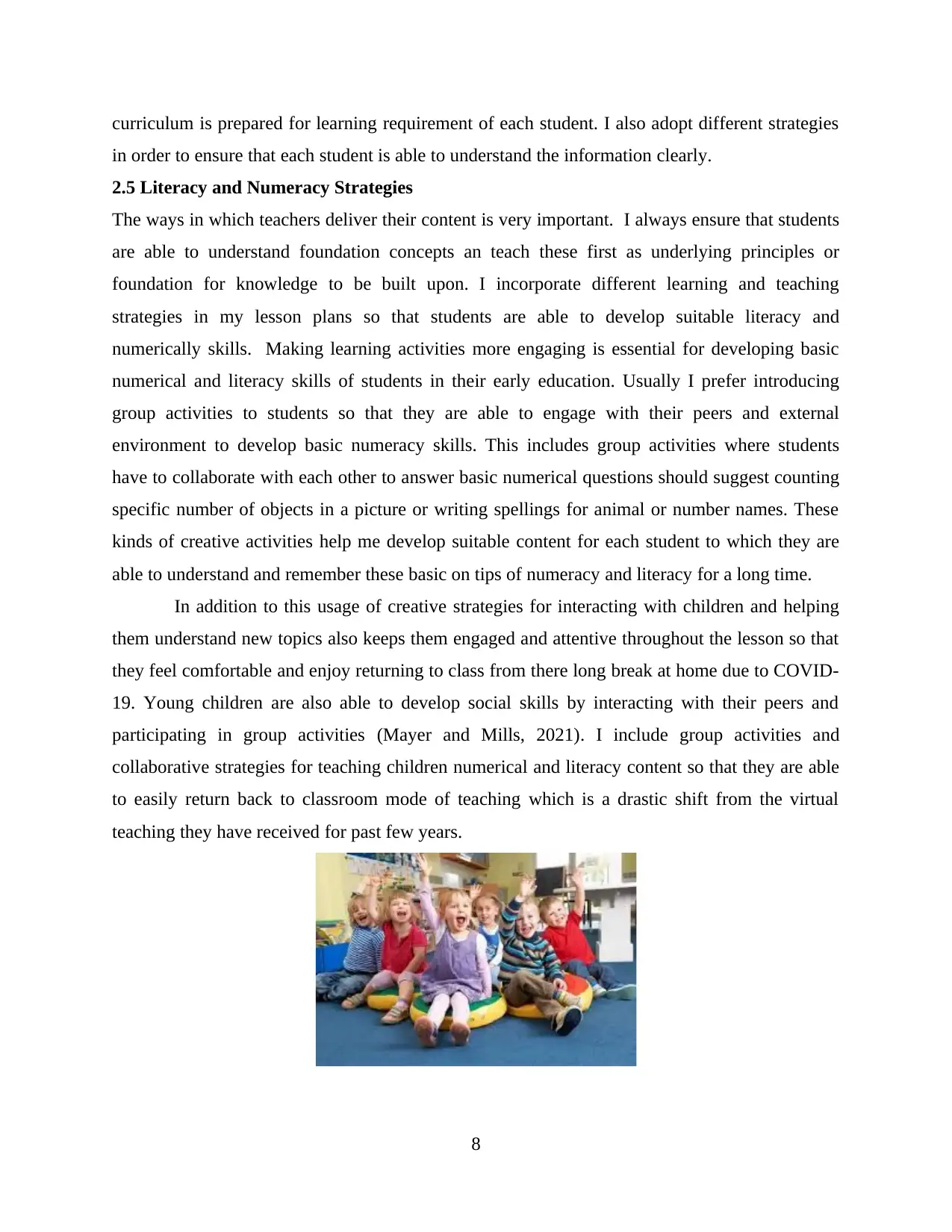
curriculum is prepared for learning requirement of each student. I also adopt different strategies
in order to ensure that each student is able to understand the information clearly.
2.5 Literacy and Numeracy Strategies
The ways in which teachers deliver their content is very important. I always ensure that students
are able to understand foundation concepts an teach these first as underlying principles or
foundation for knowledge to be built upon. I incorporate different learning and teaching
strategies in my lesson plans so that students are able to develop suitable literacy and
numerically skills. Making learning activities more engaging is essential for developing basic
numerical and literacy skills of students in their early education. Usually I prefer introducing
group activities to students so that they are able to engage with their peers and external
environment to develop basic numeracy skills. This includes group activities where students
have to collaborate with each other to answer basic numerical questions should suggest counting
specific number of objects in a picture or writing spellings for animal or number names. These
kinds of creative activities help me develop suitable content for each student to which they are
able to understand and remember these basic on tips of numeracy and literacy for a long time.
In addition to this usage of creative strategies for interacting with children and helping
them understand new topics also keeps them engaged and attentive throughout the lesson so that
they feel comfortable and enjoy returning to class from there long break at home due to COVID-
19. Young children are also able to develop social skills by interacting with their peers and
participating in group activities (Mayer and Mills, 2021). I include group activities and
collaborative strategies for teaching children numerical and literacy content so that they are able
to easily return back to classroom mode of teaching which is a drastic shift from the virtual
teaching they have received for past few years.
8
in order to ensure that each student is able to understand the information clearly.
2.5 Literacy and Numeracy Strategies
The ways in which teachers deliver their content is very important. I always ensure that students
are able to understand foundation concepts an teach these first as underlying principles or
foundation for knowledge to be built upon. I incorporate different learning and teaching
strategies in my lesson plans so that students are able to develop suitable literacy and
numerically skills. Making learning activities more engaging is essential for developing basic
numerical and literacy skills of students in their early education. Usually I prefer introducing
group activities to students so that they are able to engage with their peers and external
environment to develop basic numeracy skills. This includes group activities where students
have to collaborate with each other to answer basic numerical questions should suggest counting
specific number of objects in a picture or writing spellings for animal or number names. These
kinds of creative activities help me develop suitable content for each student to which they are
able to understand and remember these basic on tips of numeracy and literacy for a long time.
In addition to this usage of creative strategies for interacting with children and helping
them understand new topics also keeps them engaged and attentive throughout the lesson so that
they feel comfortable and enjoy returning to class from there long break at home due to COVID-
19. Young children are also able to develop social skills by interacting with their peers and
participating in group activities (Mayer and Mills, 2021). I include group activities and
collaborative strategies for teaching children numerical and literacy content so that they are able
to easily return back to classroom mode of teaching which is a drastic shift from the virtual
teaching they have received for past few years.
8
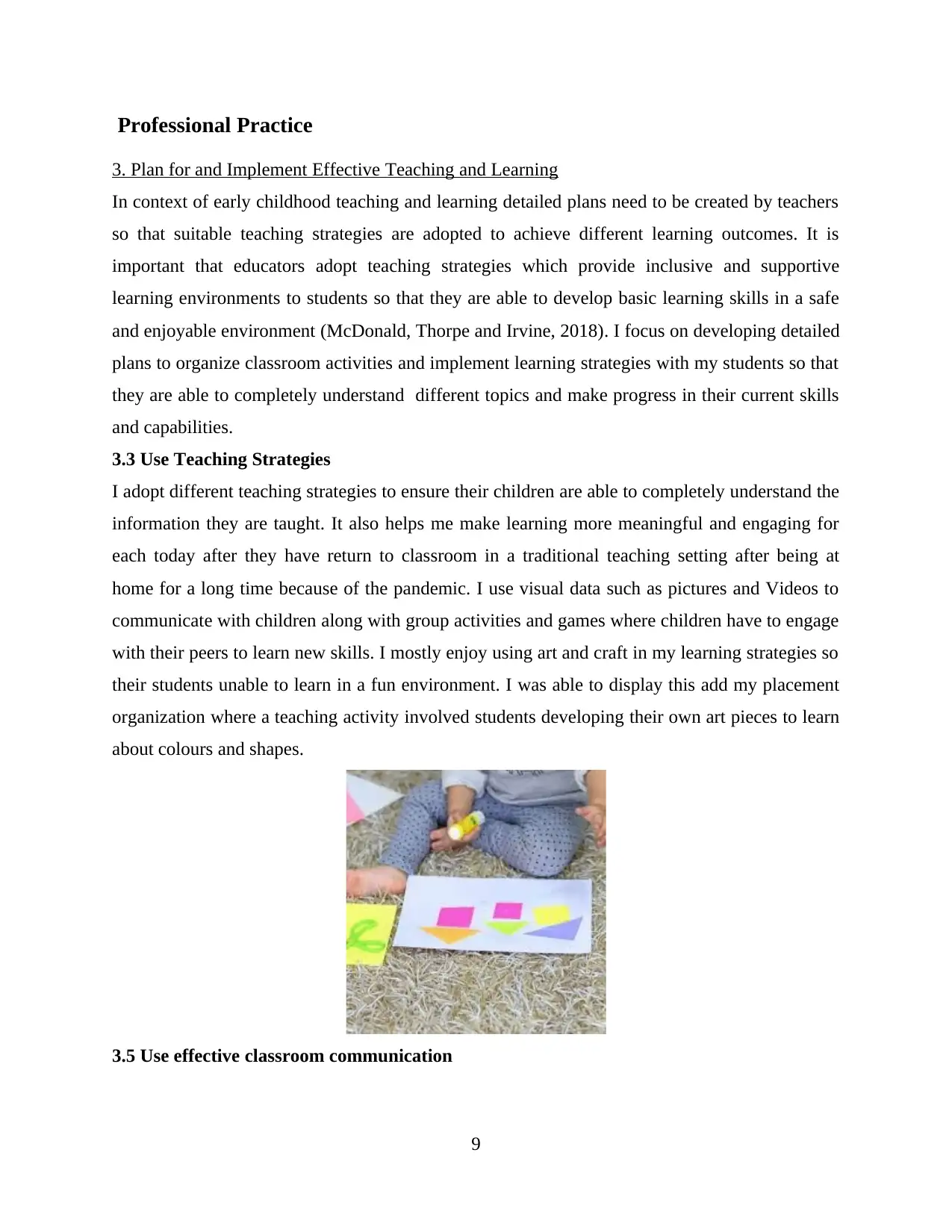
Professional Practice
3. Plan for and Implement Effective Teaching and Learning
In context of early childhood teaching and learning detailed plans need to be created by teachers
so that suitable teaching strategies are adopted to achieve different learning outcomes. It is
important that educators adopt teaching strategies which provide inclusive and supportive
learning environments to students so that they are able to develop basic learning skills in a safe
and enjoyable environment (McDonald, Thorpe and Irvine, 2018). I focus on developing detailed
plans to organize classroom activities and implement learning strategies with my students so that
they are able to completely understand different topics and make progress in their current skills
and capabilities.
3.3 Use Teaching Strategies
I adopt different teaching strategies to ensure their children are able to completely understand the
information they are taught. It also helps me make learning more meaningful and engaging for
each today after they have return to classroom in a traditional teaching setting after being at
home for a long time because of the pandemic. I use visual data such as pictures and Videos to
communicate with children along with group activities and games where children have to engage
with their peers to learn new skills. I mostly enjoy using art and craft in my learning strategies so
their students unable to learn in a fun environment. I was able to display this add my placement
organization where a teaching activity involved students developing their own art pieces to learn
about colours and shapes.
3.5 Use effective classroom communication
9
3. Plan for and Implement Effective Teaching and Learning
In context of early childhood teaching and learning detailed plans need to be created by teachers
so that suitable teaching strategies are adopted to achieve different learning outcomes. It is
important that educators adopt teaching strategies which provide inclusive and supportive
learning environments to students so that they are able to develop basic learning skills in a safe
and enjoyable environment (McDonald, Thorpe and Irvine, 2018). I focus on developing detailed
plans to organize classroom activities and implement learning strategies with my students so that
they are able to completely understand different topics and make progress in their current skills
and capabilities.
3.3 Use Teaching Strategies
I adopt different teaching strategies to ensure their children are able to completely understand the
information they are taught. It also helps me make learning more meaningful and engaging for
each today after they have return to classroom in a traditional teaching setting after being at
home for a long time because of the pandemic. I use visual data such as pictures and Videos to
communicate with children along with group activities and games where children have to engage
with their peers to learn new skills. I mostly enjoy using art and craft in my learning strategies so
their students unable to learn in a fun environment. I was able to display this add my placement
organization where a teaching activity involved students developing their own art pieces to learn
about colours and shapes.
3.5 Use effective classroom communication
9
⊘ This is a preview!⊘
Do you want full access?
Subscribe today to unlock all pages.

Trusted by 1+ million students worldwide
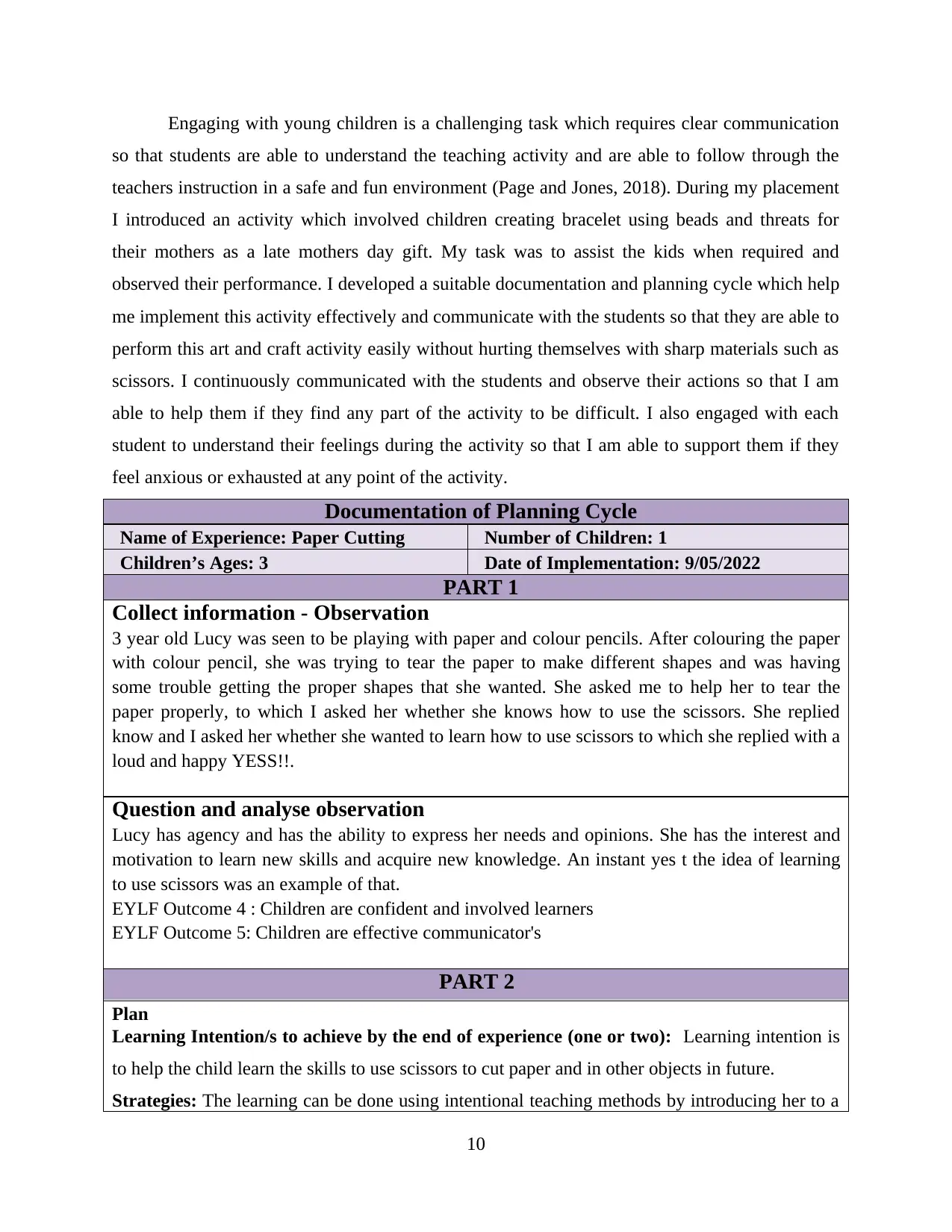
Engaging with young children is a challenging task which requires clear communication
so that students are able to understand the teaching activity and are able to follow through the
teachers instruction in a safe and fun environment (Page and Jones, 2018). During my placement
I introduced an activity which involved children creating bracelet using beads and threats for
their mothers as a late mothers day gift. My task was to assist the kids when required and
observed their performance. I developed a suitable documentation and planning cycle which help
me implement this activity effectively and communicate with the students so that they are able to
perform this art and craft activity easily without hurting themselves with sharp materials such as
scissors. I continuously communicated with the students and observe their actions so that I am
able to help them if they find any part of the activity to be difficult. I also engaged with each
student to understand their feelings during the activity so that I am able to support them if they
feel anxious or exhausted at any point of the activity.
Documentation of Planning Cycle
Name of Experience: Paper Cutting Number of Children: 1
Children’s Ages: 3 Date of Implementation: 9/05/2022
PART 1
Collect information - Observation
3 year old Lucy was seen to be playing with paper and colour pencils. After colouring the paper
with colour pencil, she was trying to tear the paper to make different shapes and was having
some trouble getting the proper shapes that she wanted. She asked me to help her to tear the
paper properly, to which I asked her whether she knows how to use the scissors. She replied
know and I asked her whether she wanted to learn how to use scissors to which she replied with a
loud and happy YESS!!.
Question and analyse observation
Lucy has agency and has the ability to express her needs and opinions. She has the interest and
motivation to learn new skills and acquire new knowledge. An instant yes t the idea of learning
to use scissors was an example of that.
EYLF Outcome 4 : Children are confident and involved learners
EYLF Outcome 5: Children are effective communicator's
PART 2
Plan
Learning Intention/s to achieve by the end of experience (one or two): Learning intention is
to help the child learn the skills to use scissors to cut paper and in other objects in future.
Strategies: The learning can be done using intentional teaching methods by introducing her to a
10
so that students are able to understand the teaching activity and are able to follow through the
teachers instruction in a safe and fun environment (Page and Jones, 2018). During my placement
I introduced an activity which involved children creating bracelet using beads and threats for
their mothers as a late mothers day gift. My task was to assist the kids when required and
observed their performance. I developed a suitable documentation and planning cycle which help
me implement this activity effectively and communicate with the students so that they are able to
perform this art and craft activity easily without hurting themselves with sharp materials such as
scissors. I continuously communicated with the students and observe their actions so that I am
able to help them if they find any part of the activity to be difficult. I also engaged with each
student to understand their feelings during the activity so that I am able to support them if they
feel anxious or exhausted at any point of the activity.
Documentation of Planning Cycle
Name of Experience: Paper Cutting Number of Children: 1
Children’s Ages: 3 Date of Implementation: 9/05/2022
PART 1
Collect information - Observation
3 year old Lucy was seen to be playing with paper and colour pencils. After colouring the paper
with colour pencil, she was trying to tear the paper to make different shapes and was having
some trouble getting the proper shapes that she wanted. She asked me to help her to tear the
paper properly, to which I asked her whether she knows how to use the scissors. She replied
know and I asked her whether she wanted to learn how to use scissors to which she replied with a
loud and happy YESS!!.
Question and analyse observation
Lucy has agency and has the ability to express her needs and opinions. She has the interest and
motivation to learn new skills and acquire new knowledge. An instant yes t the idea of learning
to use scissors was an example of that.
EYLF Outcome 4 : Children are confident and involved learners
EYLF Outcome 5: Children are effective communicator's
PART 2
Plan
Learning Intention/s to achieve by the end of experience (one or two): Learning intention is
to help the child learn the skills to use scissors to cut paper and in other objects in future.
Strategies: The learning can be done using intentional teaching methods by introducing her to a
10
Paraphrase This Document
Need a fresh take? Get an instant paraphrase of this document with our AI Paraphraser
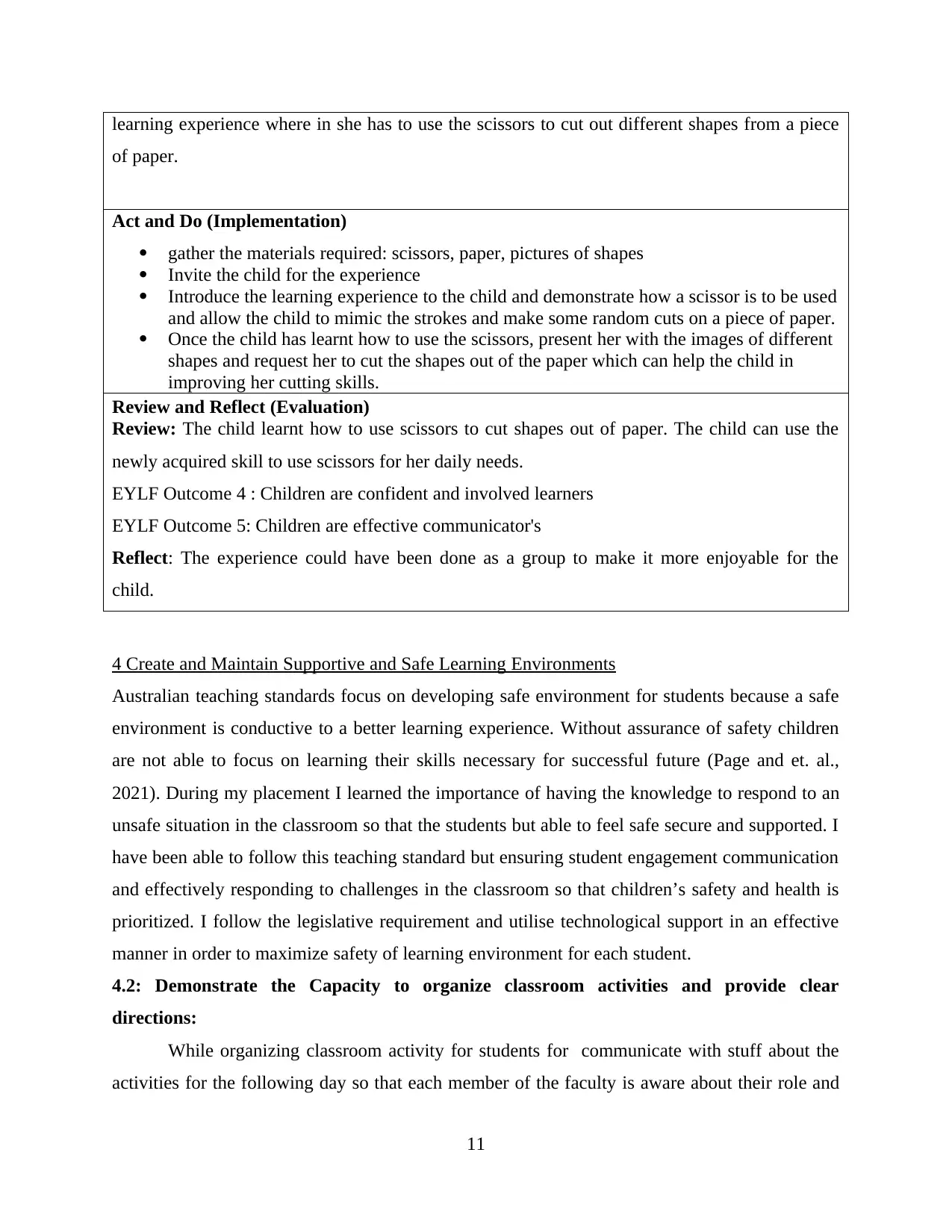
learning experience where in she has to use the scissors to cut out different shapes from a piece
of paper.
Act and Do (Implementation)
gather the materials required: scissors, paper, pictures of shapes
Invite the child for the experience
Introduce the learning experience to the child and demonstrate how a scissor is to be used
and allow the child to mimic the strokes and make some random cuts on a piece of paper.
Once the child has learnt how to use the scissors, present her with the images of different
shapes and request her to cut the shapes out of the paper which can help the child in
improving her cutting skills.
Review and Reflect (Evaluation)
Review: The child learnt how to use scissors to cut shapes out of paper. The child can use the
newly acquired skill to use scissors for her daily needs.
EYLF Outcome 4 : Children are confident and involved learners
EYLF Outcome 5: Children are effective communicator's
Reflect: The experience could have been done as a group to make it more enjoyable for the
child.
4 Create and Maintain Supportive and Safe Learning Environments
Australian teaching standards focus on developing safe environment for students because a safe
environment is conductive to a better learning experience. Without assurance of safety children
are not able to focus on learning their skills necessary for successful future (Page and et. al.,
2021). During my placement I learned the importance of having the knowledge to respond to an
unsafe situation in the classroom so that the students but able to feel safe secure and supported. I
have been able to follow this teaching standard but ensuring student engagement communication
and effectively responding to challenges in the classroom so that children’s safety and health is
prioritized. I follow the legislative requirement and utilise technological support in an effective
manner in order to maximize safety of learning environment for each student.
4.2: Demonstrate the Capacity to organize classroom activities and provide clear
directions:
While organizing classroom activity for students for communicate with stuff about the
activities for the following day so that each member of the faculty is aware about their role and
11
of paper.
Act and Do (Implementation)
gather the materials required: scissors, paper, pictures of shapes
Invite the child for the experience
Introduce the learning experience to the child and demonstrate how a scissor is to be used
and allow the child to mimic the strokes and make some random cuts on a piece of paper.
Once the child has learnt how to use the scissors, present her with the images of different
shapes and request her to cut the shapes out of the paper which can help the child in
improving her cutting skills.
Review and Reflect (Evaluation)
Review: The child learnt how to use scissors to cut shapes out of paper. The child can use the
newly acquired skill to use scissors for her daily needs.
EYLF Outcome 4 : Children are confident and involved learners
EYLF Outcome 5: Children are effective communicator's
Reflect: The experience could have been done as a group to make it more enjoyable for the
child.
4 Create and Maintain Supportive and Safe Learning Environments
Australian teaching standards focus on developing safe environment for students because a safe
environment is conductive to a better learning experience. Without assurance of safety children
are not able to focus on learning their skills necessary for successful future (Page and et. al.,
2021). During my placement I learned the importance of having the knowledge to respond to an
unsafe situation in the classroom so that the students but able to feel safe secure and supported. I
have been able to follow this teaching standard but ensuring student engagement communication
and effectively responding to challenges in the classroom so that children’s safety and health is
prioritized. I follow the legislative requirement and utilise technological support in an effective
manner in order to maximize safety of learning environment for each student.
4.2: Demonstrate the Capacity to organize classroom activities and provide clear
directions:
While organizing classroom activity for students for communicate with stuff about the
activities for the following day so that each member of the faculty is aware about their role and
11
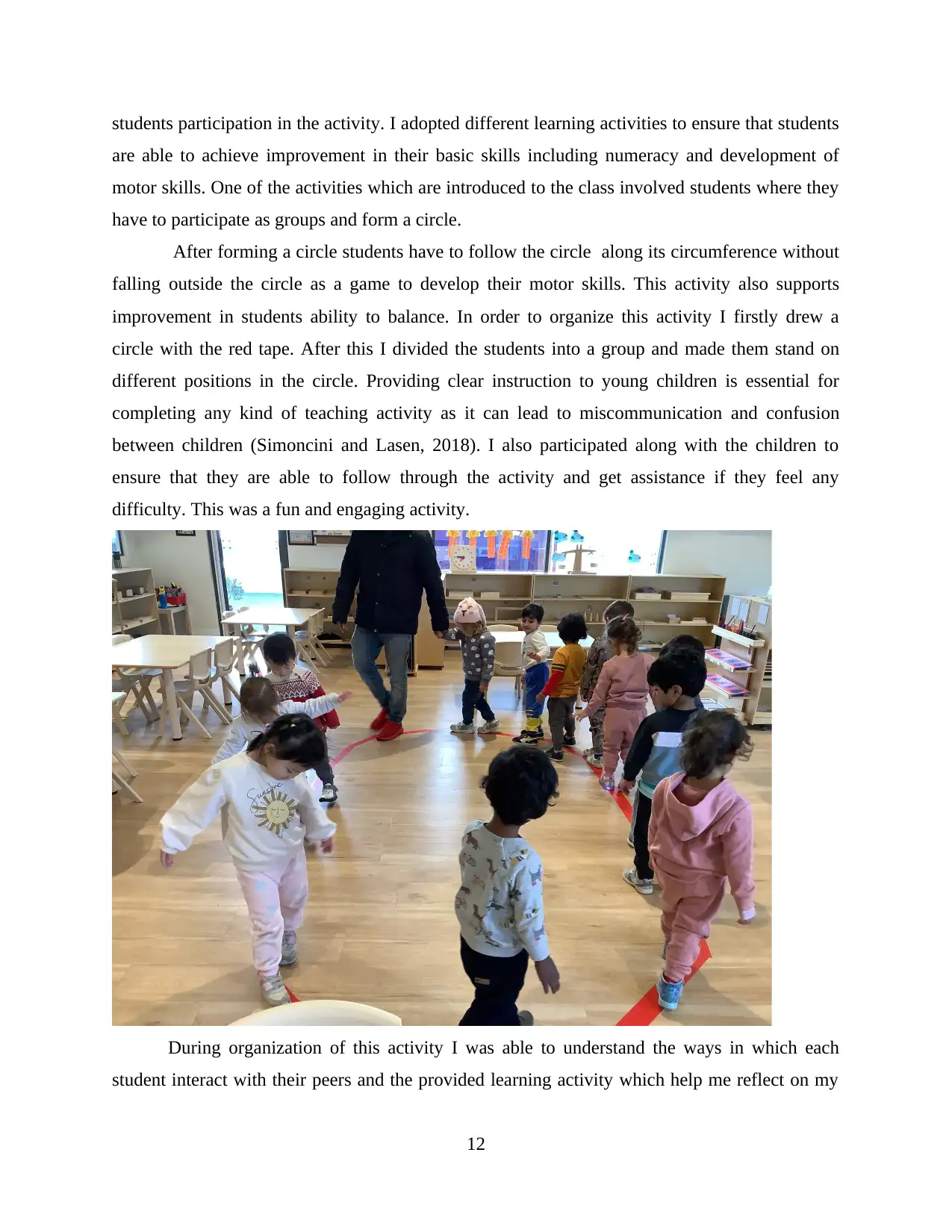
students participation in the activity. I adopted different learning activities to ensure that students
are able to achieve improvement in their basic skills including numeracy and development of
motor skills. One of the activities which are introduced to the class involved students where they
have to participate as groups and form a circle.
After forming a circle students have to follow the circle along its circumference without
falling outside the circle as a game to develop their motor skills. This activity also supports
improvement in students ability to balance. In order to organize this activity I firstly drew a
circle with the red tape. After this I divided the students into a group and made them stand on
different positions in the circle. Providing clear instruction to young children is essential for
completing any kind of teaching activity as it can lead to miscommunication and confusion
between children (Simoncini and Lasen, 2018). I also participated along with the children to
ensure that they are able to follow through the activity and get assistance if they feel any
difficulty. This was a fun and engaging activity.
During organization of this activity I was able to understand the ways in which each
student interact with their peers and the provided learning activity which help me reflect on my
12
are able to achieve improvement in their basic skills including numeracy and development of
motor skills. One of the activities which are introduced to the class involved students where they
have to participate as groups and form a circle.
After forming a circle students have to follow the circle along its circumference without
falling outside the circle as a game to develop their motor skills. This activity also supports
improvement in students ability to balance. In order to organize this activity I firstly drew a
circle with the red tape. After this I divided the students into a group and made them stand on
different positions in the circle. Providing clear instruction to young children is essential for
completing any kind of teaching activity as it can lead to miscommunication and confusion
between children (Simoncini and Lasen, 2018). I also participated along with the children to
ensure that they are able to follow through the activity and get assistance if they feel any
difficulty. This was a fun and engaging activity.
During organization of this activity I was able to understand the ways in which each
student interact with their peers and the provided learning activity which help me reflect on my
12
⊘ This is a preview!⊘
Do you want full access?
Subscribe today to unlock all pages.

Trusted by 1+ million students worldwide
1 out of 20
Related Documents
Your All-in-One AI-Powered Toolkit for Academic Success.
+13062052269
info@desklib.com
Available 24*7 on WhatsApp / Email
![[object Object]](/_next/static/media/star-bottom.7253800d.svg)
Unlock your academic potential
Copyright © 2020–2025 A2Z Services. All Rights Reserved. Developed and managed by ZUCOL.





